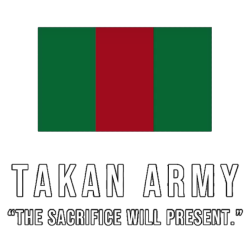Takan Army
The Takan Army is a branch of the Takan Armed Forces. It is the primary force of the Takan Military and carries many roles that are fulfilled by a plethora of different units.
History
Pre-Vergada
Before the Battle of Vergada in 1953, the Royal Takan Army was a force for offense, and expedition, created with the goal of expanding the borders of Take Kä. Initially the force attempted to balance a two front war with the northern state of Galacia, and Carmogathy (Spain) directly to the East. While progress was slow, the military was making slow advances to the North, until a new front opened in the South when Portugal launched an invasion on Take Kä's Southern borders. The events in the South led to a crippling halt and reversal of expansion on the North and Eastern fronts of the war, as Portugal's several surprise attacks on unprotected supply routes created a major logistical disadvantage. After losing the supply routes, the Takan Military drew soldiers from the frontlines of the Northern and Eastern fronts to defend the southern borders, which were pushed back to the town of Vergada.
The Battle of Vergada
As the Portuguese continued the push North into Takan territory, a stalemate occurred in the town of Vergada, where soldiers dug trenches and engaged in many deadly engagements. One of such engagements was the 36 hour skirmish nicknamed the "Battle of the Burning Forest" as a record amount of soldiers on both sides were killed in engagements that involved flamethrowers, indirect fire, and bombs, including heavy use of napalm. Five days after the Battle of the Burning Forest occurred, soldiers on the frontlines began to lose the will to fight, and started to surrender. News of the mass surrendering lead to the president in office to step down.
1954-2000s
After the president stepped down, the Royal Takan Army was abolished, and reformed a year later as the Takan Ground Forces. Recruitment was a major issue for the Ground Forces due to negative civilian perception of the military due to Take Kä's recent military history. It wasn't until the 1980's where the Ground Forces rebranded to the Takan Army, and started offering benefits that exceeded the benefits one could obtain working a regular job. This new Takan Army remained a peaceful force until the early 2000's when the war on terror began. During this period, the Takan Army would see a major deployment of soldiers to the regions of Iraq, and most notably Afghanistan.
Camp Mandol
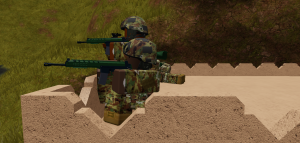
In 2004, Camp Mandol was founded in the mountainous province of Nuristan Afghanistan, this region was seen by a reported 80% of Takan soldiers who deployed during the time period. Manned by the 7th Infantry Division, Camp Mandol oversaw and provided security for a total of over two hundred and fifty square miles surrounding the base. After 6 years of controlling the area, on September 10th, 2010, 7INF was brought back home on orders to become the primary training unit of the Takan Army's new Training & Recruiting Command, and was replaced by the 1st Infantry Division. The 1st Infantry Division spent the remaining 5 years at Mandol, earning the "Mountain" tab over the unit insignia, and left the region after handing control to the Austris Armed Forces. When 1INF returned home in 2015, they were welcomed as the last Takan unit to leave the Middle East, and began training to be able to fight in jungle environments.
ICTO Era
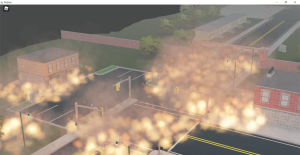
In 2020, due to a lack of engagement in diplomatic relations with the world, many political outbursts occured, including protests, riots, and more. The period of turmoil led to the activation of the Takan Army's Royal Guard, more widely known as the National Gendarmerie. It wasn't until late 2020, when the government agreed to join ICTO when the turmoil subsided.
Fort Duncan Riots
Following the political outbursts in 2020 due to lack of external engagement with the world, a group of twelve Takan residents attacked the gates of Fort Duncan. There was no clear message as to why they attacked, or no apparent target. Unfortunately, the attack, using homemade Molotov Cocktails, and legally obtained firearms lead to over a half-million dollar loss in equipment and property damages, as well as the loss of a life.
Battle of Vas
In June of 2021, the Takan Army was tasked with security operations on the border of Aresia in defense of neutral nations that risked being invaded. While completing security missions the Takan Army was met with multiple skirmishes, including the Battle of Vas. The Battle of Vas, also known as the Battle for Vas was a several hour long engagement along the Vas river where forces on both sides dug trenches along both riverbanks. Although making significant pushes against the Aresian military, the Takan Army intentionally broke contact with the force to limit casualties and potential long-term logistical issues.
Engagement with the SWS
In August of 2021, a terrorist attack occured in downtown Brayles, days after the scene was secured by the National Gendarmerie, an organization known as the SWS, or the State of West Sahara claimed responsibility for the attack. Within 24 hours, the 2nd Airborne Corps activated the 3rd Airborne Division, and founded the 10th Ordinance Support Regiment. Both groups were deployed to the region and conducted security operations there. After only four days on rotation, 10OSR would report that it has successfully destroyed over a thousand vital targets including IED factories, training facilities, terrorist cells, and more. After the sweeping success, both 3AIR, and 10OSR would return home, with SWS threat subsided.
Terra Era
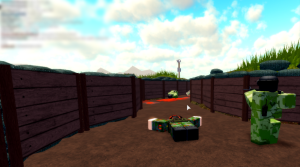
Carmo-Danub War
In October of 2021, ICTO reformed to the Terra community, which brought many new political relationships to the table, including the contentious relationship between Take Kä and Danubia. In the beginning of October, the republic of Danubia began expanding territory, which erupted in the Carmo-Danub War. Fighting in alliance with Carmogathy (Spain), the Takan Army engaged in multiple battles against the Danubian military. Days after Danubia's invasion, Carmogathy suffered a crushing defeat which lost in major loss of life for the Takan Army, and the Carmogathan Army, which surrendered after the final loss.
Battle of Kandahar
After Carmogathy's surrender, Danubia's ally, Classikstan made a push into Carmogathy held territory in Afghanistan attempting to completely wipe out the remainder of the Carmogathan Army. In attempts to limit casualties, the Takan Army aided in the evacuation of members of the Carmogathy Military, and security operations in the area. Days after the evacuation of the Carmogathy Military, the Takan Army made contact with forces from both the Danubian and Classikstani militaries in Kandahar, where the Takan Army suffered a decisive loss.
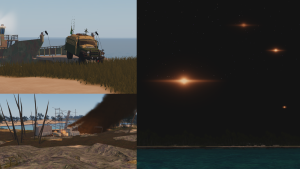
War Against Portugal Era
Following almost a year of peace and the collapse of the Terra community, the Portuguese again began an offensive push against the Southern Takan borders, leading to several long battles. In attempts to strategically disable the Portuguese military, the Takan Army began the invasion of the island of Porto Santo, a major training center for the Portuguese Military. In March of 2022, the Takan Army began launching precision air-to-ground strikes on the island destroying strategic targets, and disabling the island's power grid. The morning after the full night of bombardment, the 4th Cavalry Division began a land invasion following the establishment of a beachhead. Within 48 hours, the island was entirely under control of the Takan Army, and the war ended with the ceasing of Porto Santo to Take Kä, and the establishment of Take Kä's Southern Border Demilitarized Zone (SBDMZ).
Modern Day
Since the invasion of Porto Santo in 2022, the Takan Army has not been on any notable assignments. "The peacetime Army is an Army of preparation for wartime." Military Chairman General (AL3) caelanserrano states. Since Porto Santo the Takan Army has been primarily focused on training, construction of better bases and infrastructure, and foreign relations. It wasn't until the start of 2023 where the Takan Army began offering the opportunity to train soldiers from foreign allied nations, bringing about the Foreign Student Program (FSP), widely known as Foreign Exchange.
Foreign Intervention
In the recent month of February, 2024, the Takan Army found itself on high alert for deployment in the events of the Texan-Austris War, where footage and reports of the 5th Elite Forces Regiment's 504th Foreign Intervention Team (FIT) where found in engagements.
Organization
The Takan Army merely resembles the United States Army when it comes to organization. While lacking some ranks in comparison to the US Army, the Takan Army has three different classes of ranks: administrative levels, officer levels, and enlisted levels.
Ranks and Insignia
Administrative Level [AL]
| Rank Group | Admin Level | ||
|---|---|---|---|
| Insignia | 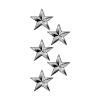
|
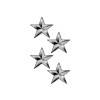
|
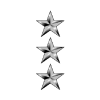
|
| Level | AL-3 | AL-2 | AL-1 |
| Title | Chairman General | Major General | Corps General |
| Abbreviation | GEN5 | GEN4 | GEN3 |
Officer Level [OL]
| Rank Group | General Officer | Senior Officer | Junior Officer | |||
|---|---|---|---|---|---|---|
| Insignia | 
|

|

|

|
 |

|
| Level | OL-6 | OL-5 | OL-4 | OL-3 | OL-2 | OL-1 |
| Title | Division General | Brigade General | Colonel | Major | Captain | Lieutenant |
| Abbreviation | GEN2 | GEN1 | COL | MAJ | CPT | LT |
Enlisted Level [EL]
| Rank Group | Senior Non-commissioned Officer | Non-commissioned Officer | Junior Enlisted | ||||
|---|---|---|---|---|---|---|---|
| Insignia | 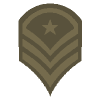
|
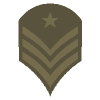
|
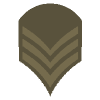
|
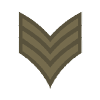
|
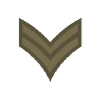
|
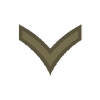
|
No insignia |
| Level | EL-7 | EL-6 | EL-5 | EL-4 | EL-3 | EL-2 | EL-1 |
| Title | Sergeant Major | First Sergeant | Staff Sergeant | Sergeant | Corporal | Private First Class | Private |
| Abbreviation | SGM | 1SG | SSG | SGT | CPL | PFC | PVT |
Foreign Student [FS]
| Rank Group | Officer | Enlisted |
|---|---|---|
| Insignia | No insignia | 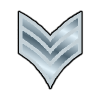
|
| Level | FS-4 | FS-4 |
| Title | Foreign Student | Foreign Student |
At the beginning of 2024, the Takan Army started offering education for soldiers of allied nations. This allowed soldiers from other nations to attend different courses the Takan Army hosted, most notably, the Takan Army's Basic Parachutist Course, Basic Military Training, and Special Operations pipeline courses. It is important to note that despite the rank of the foreign soldier, they are always granted the rank of FS-4 when working with the Takan Army. While the rank of FS-4 has no power by itself, it can be granted authority by course cadre.
Units
General Command Group (GENCOM)
The General Command Group, or GENCOM, is the primary command unit within the Takan Military. With GENCOM being the overseer command group of the entire Takan Military, it has units from both the Takan Army, and the Takan National Gendarmerie underneath it, allowing it to play a role as the military's high command. All orders and commands are passed down from GENCOM, usually with the only person above it being the president himself, GENCOM also acts as an agency of approval for matters that cannot be handled at unit level.
Training Command (TRACOM)
The Training Command, also known as the Training & Recruiting Command, or just TRACOM, is the Takan Army's primary training doctrine. TRACOM holds authority over all major training operations that are not done by a particular unit, such as 3AIR's Airborne School. In the case where a training is required that cannot be organized by one unit, TRACOM will organize, plan, and complete the training, as well as develop plans to continue similar training at smaller, unit-friendly scale. TRACOM's only unit, the 7th Infantry Division, was a previously active combat unit until it was subjugated into TRACOM in 2020, where it's new mission is to complete the process of pushing recruits through the initial training pipeline of Basic Military Training, and Advanced Military Training.
Special Operations Command (SOCOM)
While other commands are able to handle normal mission-sets, SOCOM comes into play when dealing with matters of irregular warfare. SOCOM is in charge of training, maintaining, and deploying special units to engage in situations where conventional warfare fails. SOCOM manages the Tier II and Tier III special operations units found in the 5th Elite Forces Regiment, or 5ELITE. 5ELITE is broken down in two sections, Elite Forces (Tier II Special Operations), and Special Forces (Tier III Special Operations), while both are special operations, they have varying mission-sets, and capabilities allowing them to complete even the most challenging of assigned tasks.
Combat Operations Command (COPCOM)
The Takan Army's biggest command, Combat Operations Command, COPCOM, holds two corps, the 2nd Airborne Corps: a group of three units specially capable of mass airborne, air assault, and aviation operations, and the 8th Corps. While COPCOM is the main combat force of the Army, most deployments and assignments fall on the 2nd Airborne Corps, as opposed to the 8th Corps, as the 2nd Corps is significantly better funded, and better trained. Although not receiving as many assignments, the 8th Corps is just as important, as it contains units more specialized in certain areas and types of combat, which allows for better management of more challenging tasks that require operations in water and inadequate terrain.
| Corps | 2nd Airborne Corps | 8th Corps | National Gendarmerie | |||
|---|---|---|---|---|---|---|
| Insignia | 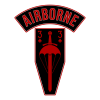
|
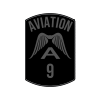
|
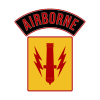
|

|
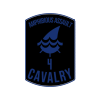
|
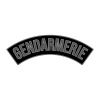
|
| Name | 3rd Airborne Division | 9th Aviation Regiment | 10th Ordinance Support Regiment | 1st Infantry Division | 4th Cavalry Division | 6th Gendarmerie Corps |
| Abbreviation | 3AIR | 9AVTN | 10OSR | 1INF | 4CAV | 6GEN |
| Primary Role | Combined Arms | Aviation | Artillery & Air Defense | Infantry | Cavalry | Military Police |
Uniforms & Equipment
Uniforms
A-Class Uniforms
The A-Class of uniforms, also known as "Alfas" is the highest level of formality in Takan military uniforms. As part of a long-standing tradition, the uniforms have stayed relatively unchanged since the issue of the first version of Alfas in 1955.
| Uniform | Service Maroons | Service Greens | Service Nights |
|---|---|---|---|
| Image | |||
| Usage | Officer's A-Class. | Enlisted A-Class. | Used primarily for mourning events & funerals. |
B-Class Uniforms
While the A-Class uniforms tend to be expensive, and extremely formal, the B-Class uniforms bring a more casual look, as well as a uniform that can be used to work in. The Utility Tans, widely known as UTANs are the oldest standing uniform in the Takan Army, with only one major change since it's inception in the 1940s.
| Uniform | Utility Tans |
|---|---|
| Image | |
| Usage | General formal working uniform. |
C-Class Uniforms
The ISU, or Improved Standard/Service Uniform is the new issued uniform, as of 2022. Made to replace the MSU, the ISU brought a simpler, and more stylish design, that offered more customizability and working variants, including the combat top and coveralls.
| Uniform | ISU | ISU Combat Top | ISU Coveralls | Tucked ISU |
|---|---|---|---|---|
| Image | ||||
| Usage | General working uniform. | Used for field environments. | Used by mechanics, and vehicle operators. | Generally to denote a soldier in training. |
Regulations
In general operations, the Takan Army typically abides by a detailed regulation code that defines how a soldier should look and act in uniform. This was implemented in 2022 to combat unprofessionalism, and to improve the perception of the Takan Army, and the individual soldier. Although the code is stated to be strict, the Army is known to make exceptions to soldiers who require them based off of religion, beliefs, and other limiting factors.
Equipment
2017-2021
2021 - Late 2023
Late 2023 - Modern Day
Weapons
2017-2021
| Name | Origin | Type | Caliber | Photo | Notes |
|---|---|---|---|---|---|
| Pistols | |||||
| Beretta M9 | Italy | Semi-Automatic Pistol | 9x19mm | 
|
Entered service in 2017 |
| Assault Rifles | |||||
| H&K XM8 | Germany | Assault Rifle | 5.56×45mm | 
|
Entered service in 2017 and used in conjunction with IA2. |
| Battle RIfles | |||||
| Imbel IA2 | Brazil | Battle Rifle | 5.56×45mm | 
|
Entered service in 2020 |
| Light Machine Guns | |||||
| H&K MG36 | Germany | Light Machine Gun | 5.56×45mm | 
|
Entered service in 2017 |
| M249 SAW | Belgium | Light Machine Gun | 5.56×45mm | 
|
Entered service in 2020 |
2021 - Late 2023
| Name | Origin | Type | Caliber | Photo | Notes |
|---|---|---|---|---|---|
| Pistols | |||||
| SDP.50 | Take Kä (Fictional) | Semi-Automatic Pistol | 9x19mm | N/A | Made by Desiño Firearms for the Takan Army in 2021 |
| SIG P320X | United States | Semi-Automatic Pistol | 9x19mm | 
|
Replaced the SDP.50 in 2023 |
| Assault Rifles | |||||
| D16M2 | Take Kä (Fictional) | Assault Rifle | 5.56×45mm | N/A | Made by Desiño Firearms for the Takan Army in 2021 |
| D16M2 Carbine | Take Kä (Fictional) | Assault Rifle | 5.56×45mm | N/A | Made by Desiño Firearms for the Takan Army in 2021 |
| D16M3 Carbine | Take Kä (Fictional) | Assault Rifle | 5.56×45mm | N/A | Made by Desiño Firearms for the TNG in 2021 |
| Light Machine Guns | |||||
| D19M1 SAW | Take Kä (Fictional) | Light Machine Gun | 7.62×51mm | ||
| C6A1 MMG | Belgium | Light Machine Gun | 7.62×51mm | 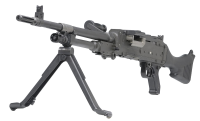
|
Replaced the D19M1 SAW in 2023 |
| Grenades | |||||
| M26 | United States | Fragmentation Grenade | N/A | 
|
|
| M18 | United States | Smoke Grenade | N/A | 
|
|
| Rocket Launchers | |||||
| AT4 | Sweden | Shoulder Fired Rocket Launcher | 84mm HEAT | 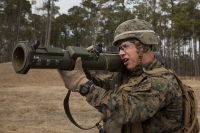
|
|
Late 2023 - Modern Day
| Name | Origin | Type | Caliber | Photo | Notes |
|---|---|---|---|---|---|
| Pistols | |||||
| SIG P320X | United States | Semi-Automatic Pistol | 9x19mm | 
|
|
| Assault Rifles | |||||
| DT MDR | United States | Bullpup Assault Rifle | 5.56×45mm | 
|
|
| Light Machine Guns | |||||
| DT MDR MG | Take Kä (Fictional) | Bullpup Light Machine Gun | 5.56×45mm | 
|
|
| Grenades | |||||
| M67 | United States | Fragmentation Grenade | N/A | 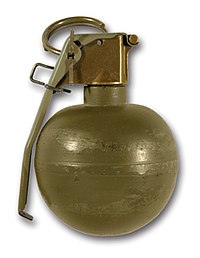
|
|
| M18 | United States | Smoke Grenade | N/A | 
|
|
| Rocket Launchers | |||||
| AT4 | Sweden | Shoulder Fired Rocket Launcher | 84mm HEAT | 
|
|
